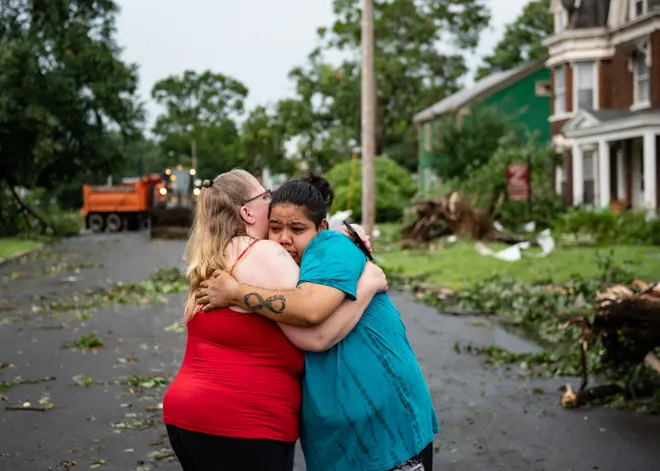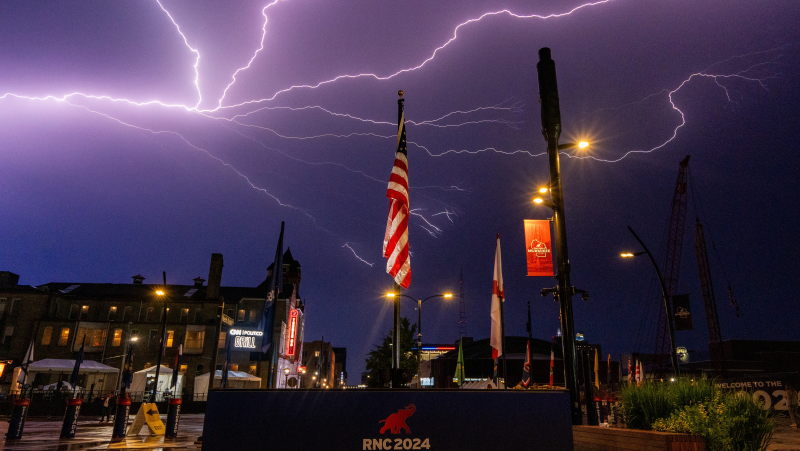Severe storms devastate upstate New York, Midwest, leaving at least 3 dead
More storms could be on the way Wednesday after severe weather − including at least one confirmed tornado − wreaked devastation across the Midwest and East Coast and left three people dead.
The National Weather Service issued a severe thunderstorm watch for a wide portion of the East Coast, stretching from Philadelphia to Boston and up to Albany, through 8 p.m.
On Tuesday, New York Gov. Kathy Hochul declared a state of emergency throughout the state after the storms caused widespread destruction, wrecking buildings and trees and leaving more than 100,000 households without power, according to poweroutage.us.
One person died in Canastota, a village around 25 miles east of Syracuse, according to an emergency declaration. "Numerous trees and wires" were ripped down in the village, and several roads were impassable, as some areas were under evacuation.
Farther east, the storms ripped through Rome, a city of 31,000, demolishing houses and uprooting trees. The National Weather Service in Binghamton confirmed that a tornado touched down in the city on Tuesday afternoon.
'It looks like a war zone'
Rome Mayor Jeffrey Lanigan said the storm tore through the town's historic downtown, pulling down the steeples of two 19th century churches and permanently changing the city skyline.
"Honestly, it looks like a war zone," Lanigan said at a news conference Tuesday evening. "It tugs on your heartstrings."
Officials warned Rome residents to avoid traveling on the streets and to be wary of downed power lines, which could be active.
Hochul posted on X that she was in touch with local officials and would deploy extra resources to impacted areas.
"When something like this happens, you tend to believe it was a tornado," Oneida County Executive Anthony Picente said at the news conference.
The weather service in Buffalo confirmed that a tornado touched down in the city of Canandaigua, about 100 miles west of Rome, just a day earlier. With a rating of EF-0, the twister traveled around three quarters of a mile, pulling up trees around Canandaigua Lake, the Rochester Democrat and Chronicle, part of the USA TODAY Network, reported.

More:Climate change is making days (a little) longer, study says
Flash floods soak Midwest, leaving 2 dead
Meanwhile, floodwaters inundated parts of Iowa, Indiana and Illinois as the area reeled from thunderstorms that soaked the region and spun up several tornadoes.
A husband and wife, both 88, were left dead after a flood washed away their car in rural Illinois on Tuesday afternoon.
The couple's sinking vehicle was spotted by a 70-year-old man, who local deputies were able to pull out of the flash flood that struck around 35 miles north of downtown St. Louis, according to the Jersey County Sheriff's Office. Authorities later found the woman dead inside her car and her husband's body on a nearby bank.
East of St. Louis, around 200 residents of Nashville, Illinois, were evacuated amid the "imminent failure" of a local dam after the area was hit with more than 6 inches of rain, local officials said. By Tuesday evening, the "immediate safety concern" had passed, and a nearby interstate highway was reopened, according to the Washington County Emergency Management Agency.
The flooding came after a derecho caused severe storms and tornadoes over the region on Monday. A derecho is a rare and destructive wind storm that can bring rapid thunderstorms and showers.
The National Weather Service confirmed 11 tornadoes moved through northern Illinois and northwest Indiana that night, including one near Chicago O'Hare International Airport, forcing travelers to shelter in place.
The weather service also confirmed an EF-1 tornado traveled near Des Moines on Monday at more than 100 mph, leaving behind widespread damage and knocking out power, the Des Moines Register, part of the USA TODAY Network, reported.
More:Utility man working to restore power in Texas arrested, accused of beating another lineman
Dozens evacuated in Arkansas amid flash floods
Widespread flash floods hit Arkansas on Wednesday after the north central part of the state was deluged with more than 10 inches in 24 hours, according to the weather service. "Numerous creeks and rivers" in the area were flooding or still rising just before noon local time, forecasters said.
The weather service extended a flood warning for areas near the White River on Wednesday afternoon as water levels rose above 21 feet that morning. The river could rise crest at 29 feet on Sunday morning.
The flooding damaged infrastructure and forced road closures and evacuations in multiple counties across the state, according to a news release emailed to USA TODAY by Arkansas Division of Emergency Management public information officer Lacey Kanipe. In the town of Flippin, around 140 miles north of Little Rock, up to 40 people were forced to evacuate.
Responders carried out water rescues after several bridges in the area were inundated, the city posted on Facebook. Local officials urged residents to avoid using city roads.
"If you do not have to leave your residences, please stay home!" the Marion County Office of Emergency Management posted to Facebook.
Around 80 residents of a nursing home in Yellville, a city around 7 miles from Flippin, were forced to evacuate, Tobias Pugsley, vice president of communications and marketing for Baxter Health, told local news. The patients were transported to the county fairgrounds, he said.
Some severe storms clear, but heat wave continues
The extreme weather briefly dissipated on Wednesday morning before the severe thunderstorm watch was issued by the weather service at around 1 p.m.
The storms could bring frequent lightning, heavy wind gusts and put the area at a slight risk of hail or tornadoes through Thursday morning, the weather service warned. Heavy rain could also trigger flash floods.
At the same time, wide swaths of the country could bake in excessive heat as a record-smashing heat wave continues on the East Coast through Wednesday.
Nearly 100 million Americans, 29% of the country, were under heat alerts on Wednesday, according to the National Integrated Heat Health Information System.

The tail end of a heat wave will scorch the I-95 corridor, including New York City, Washington, D.C., Boston, and Philadelphia, on Wednesday before a cold front brings relief on Thursday, according to the weather service. The area around the nation's capital, including parts of Maryland and Virginia, was under a heat advisory. Heat index values could reach 106 degrees on Wednesday.
The cold front could trigger more severe thunderstorms and showers later in the week. And the heat will return – the weather service said heat risk could be "major" to "extreme" in parts of the West by the weekend.
Temperatures this summer have broken records and left dozens dead. In the first five days of July, temperatures in more than 50 cities in California and Nevada set new records, according to AccuWeather. At least 30 deaths in the West this month were linked to the heat.
Disclaimer: The copyright of this article belongs to the original author. Reposting this article is solely for the purpose of information dissemination and does not constitute any investment advice. If there is any infringement, please contact us immediately. We will make corrections or deletions as necessary. Thank you.




